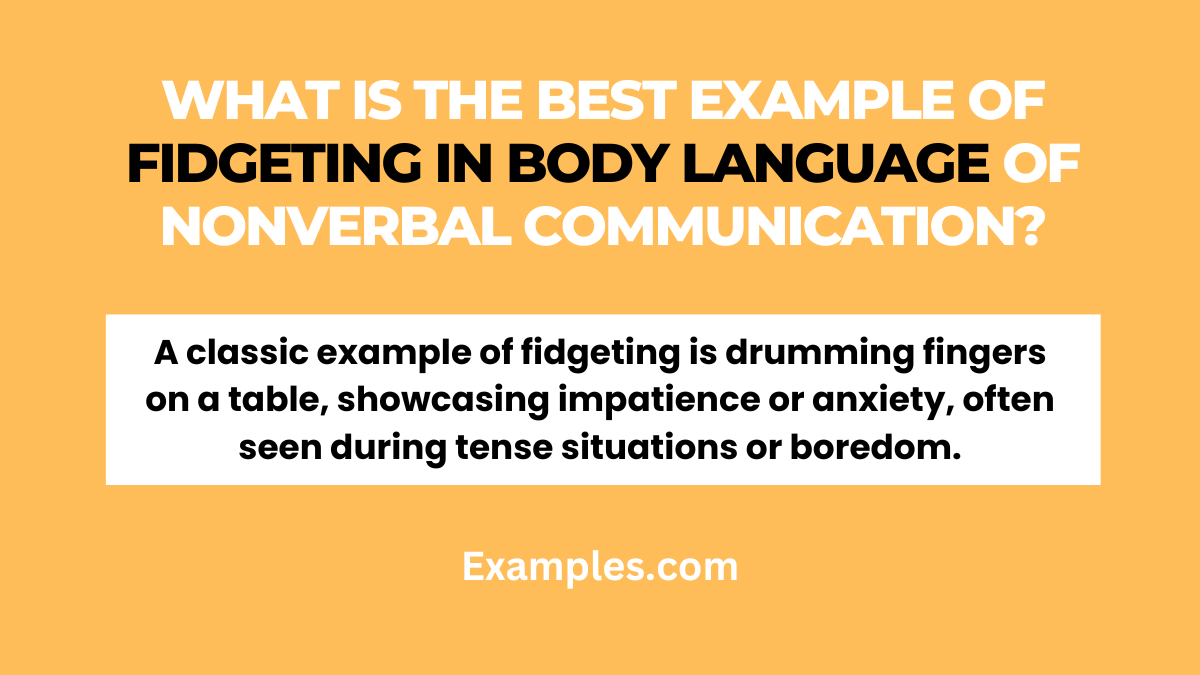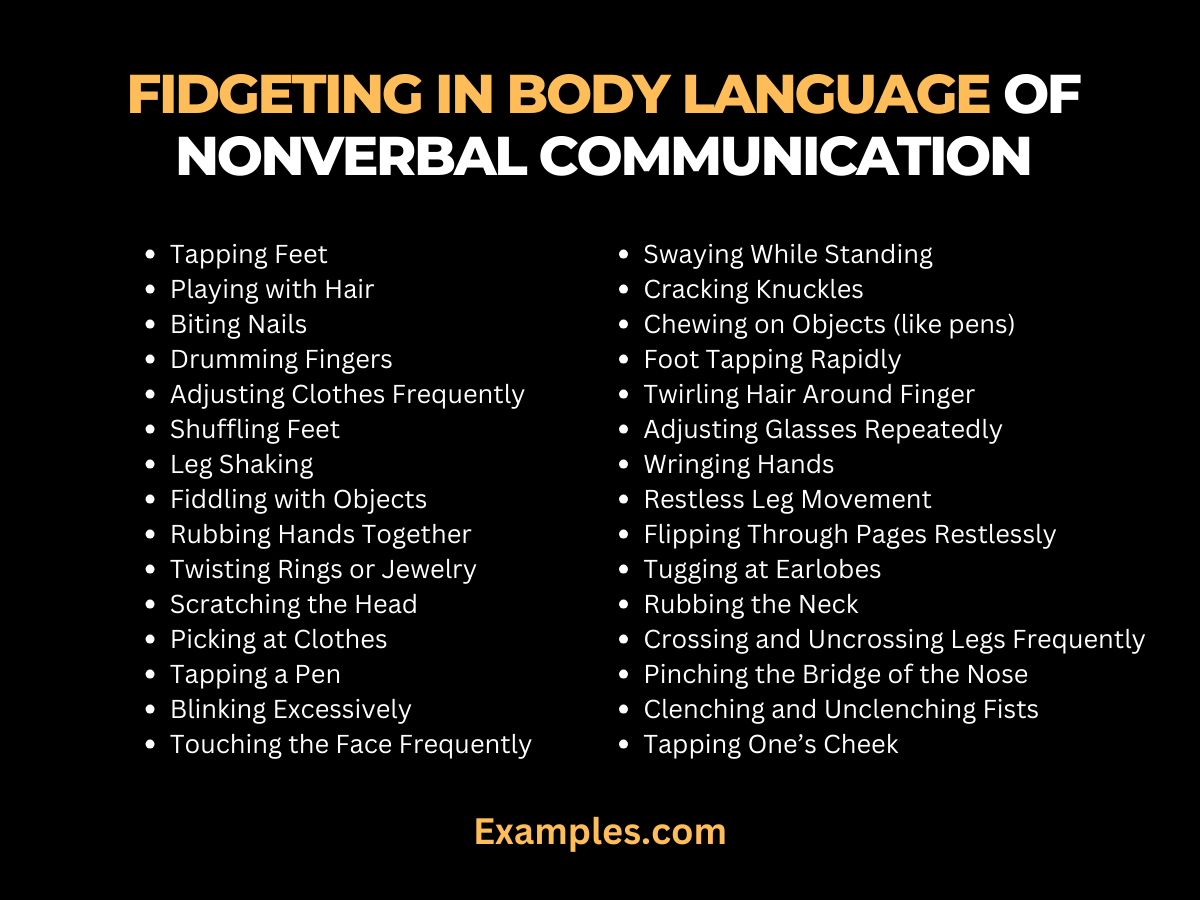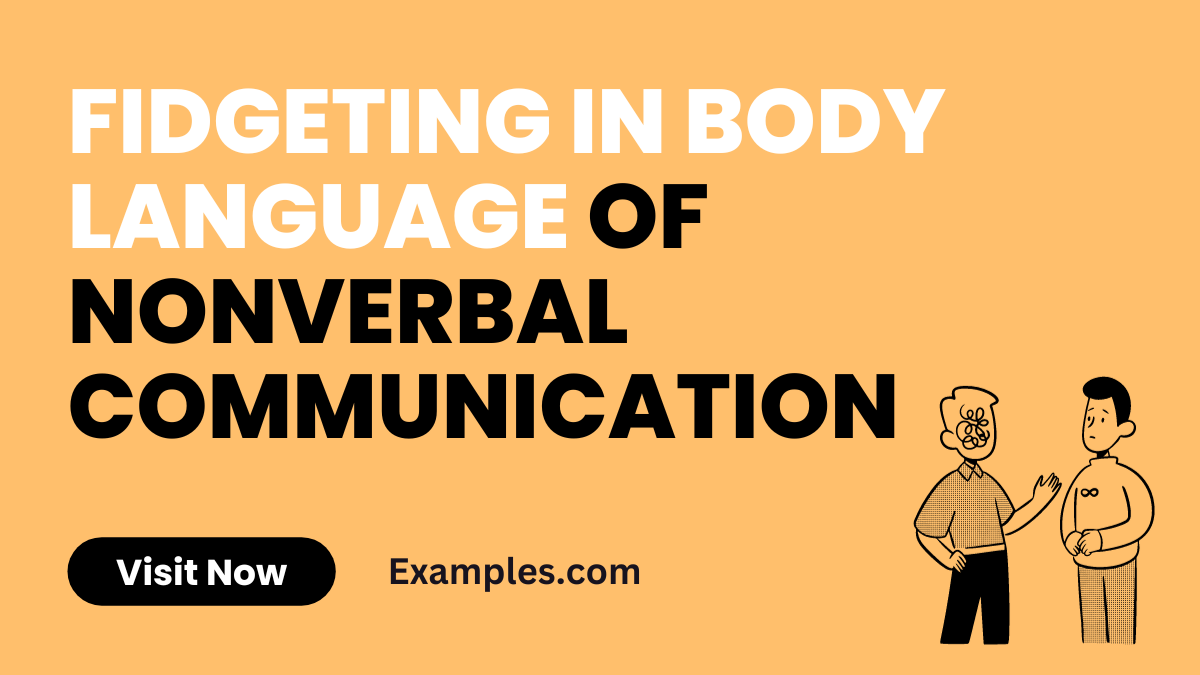Fidgeting in Body Language of Nonverbal Communication
Understanding fidgeting in body language is crucial for interpreting nonverbal communication. This guide delves into how subtle movements can convey a wealth of information. From nervous twitches to signs of boredom, we’ll explore various communication examples to help you decode the silent language of fidgeting. Whether in professional settings or personal interactions, recognizing these cues enhances your communication skills, making interactions more meaningful and insightful.
What is Fidgeting in Body Language of Nonverbal Communication?

Fidgeting in body language refers to small, often subconscious, movements or gestures that can convey a range of emotions and intentions. This includes actions like tapping feet, playing with hair, or shifting position. Fidgeting is a key component of nonverbal communication, providing insights into a person’s feelings and thoughts without the use of words. Understanding these signals is essential for effective communication, as they often reveal more than spoken language.
What is the Best Example of Fidgeting in Body Language of Nonverbal Communication?

A classic example of fidgeting in body language is when someone repeatedly taps their foot or fingers. This behavior often indicates restlessness, impatience, or nervousness. For instance, in a meeting, a participant tapping their foot might be feeling anxious or eager to conclude. Similarly, someone playing with their hair during a conversation could signal discomfort or shyness. These actions are integral parts of body language in nonverbal communication, offering a window into unspoken emotions and thoughts. Recognizing and interpreting these signals correctly can significantly enhance understanding and empathy in communication.
30 Examples of Fidgeting in Body Language of Nonverbal Communication

Understanding fidgeting in body language is crucial in deciphering nonverbal communication. This guide explores 30 distinct examples of fidgeting, each accompanied by explanations and example sentences, showcasing how these subtle cues can convey a myriad of emotions and thoughts in daily interactions. From nervous twitches to restless movements, fidgeting is a key aspect of nonverbal communication, offering insights into a person’s inner state.
- Tapping Feet: Often indicates impatience or nervous energy. Example: “While waiting for her interview, she tapped her feet, signaling her anxiety.”
- Playing with Hair: Can suggest insecurity or a contemplative state. Example: “During the meeting, his constant hair twirling hinted at his uncertainty.”
- Biting Nails: A common sign of stress or anxiety. Example: “Biting her nails during the exam was a clear sign of her nervousness.”
- Drumming Fingers: Implies impatience or boredom. Example: “His fingers drummed on the table, revealing his eagerness to leave.”
- Adjusting Clothes Frequently: May indicate discomfort or nervousness. Example: “She kept adjusting her dress, a sign of her discomfort in the new environment.”
- Shuffling Feet: Suggests restlessness or eagerness to move. Example: “His shuffling feet during the speech showed his impatience.”
- Leg Shaking: Often a sign of nervous energy or agitation. Example: “His leg shaking under the table was a clear indicator of his anxiety.”
- Fiddling with Objects: Can indicate boredom or distraction. Example: “Fiddling with her pen, she seemed disinterested in the conversation.”
- Rubbing Hands Together: May signify anticipation or anxiety. Example: “Rubbing his hands together, he displayed his nervous anticipation for the news.”
- Twisting Rings or Jewelry: Often a sign of nervousness or deep thought. Example: “Twisting her ring, she seemed lost in thought during the discussion.”
- Scratching the Head: Can indicate confusion or forgetfulness. Example: “He scratched his head, a nonverbal cue of his confusion.”
- Picking at Clothes: Suggests discomfort or a preoccupied mind. Example: “Picking at her sweater’s threads, she appeared distracted from the task at hand.”
- Tapping a Pen: Indicates impatience or a need to focus. Example: “Tapping her pen loudly, she signaled her irritation at the delay.”
- Blinking Excessively: Can be a sign of discomfort or disbelief. Example: “His excessive blinking betrayed his surprise at the announcement.”
- Touching the Face Frequently: Often a sign of uncertainty or lying. Example: “Her frequent face touching during the interrogation raised doubts about her honesty.”
- Swaying While Standing: Suggests restlessness or impatience. Example: “Swaying from side to side, he showed his restlessness during the long wait.”
- Cracking Knuckles: Can indicate nervousness or a habit of self-soothing. Example: “Cracking his knuckles, he seemed to be calming his nerves before the presentation.”
- Chewing on Objects (like pens): A sign of deep thought or stress. Example: “Chewing on her pen, she appeared deeply engrossed in solving the problem.”
- Foot Tapping Rapidly: Indicates a high level of anxiety or excitement. Example: “Her rapid foot tapping was a clear signal of her anxious state.”
- Twirling Hair Around Finger: Can suggest contemplation or insecurity. Example: “Twirling her hair around her finger, she seemed lost in thought.”
- Adjusting Glasses Repeatedly: May indicate nervousness or a thoughtful pause. Example: “He repeatedly adjusted his glasses, a sign of his careful consideration of the matter.”
- Wringing Hands: Often a sign of distress or apprehension. Example: “Wringing her hands, she conveyed her deep concern about the situation.”
- Restless Leg Movement: Indicates unease or a need for movement. Example: “His restless leg movement under the table was noticeable during the tense discussion.”
- Flipping Through Pages Restlessly: Suggests impatience or distraction. Example: “Flipping through the book restlessly, she didn’t seem focused on the content.”
- Tugging at Earlobes: Can be a sign of indecision or stress. Example: “Tugging at his earlobes, he seemed undecided about his next move.”
- Rubbing the Neck: Often indicates tension or discomfort. Example: “Rubbing his neck, he showed signs of feeling stressed during the conversation.”
- Crossing and Uncrossing Legs Frequently: Suggests discomfort or nervousness. Example: “Her constant crossing and uncrossing of legs signaled her discomfort in the meeting.”
- Pinching the Bridge of the Nose: Can indicate deep thought or frustration. Example: “Pinching the bridge of his nose, he displayed his frustration with the problem.”
- Clenching and Unclenching Fists: Suggests anger or intense concentration. Example: “Her clenched fists revealed the intensity of her emotions.”
- Tapping One’s Cheek: Indicates thoughtfulness or decision-making. Example: “Tapping her cheek gently, she pondered over the question posed to her.”
Is Fidgeting Hands Positive or Negative in Body Language?
Fidgeting hands, a common aspect of body language in nonverbal communication, can be interpreted in various ways depending on the context. Generally, fidgeting is considered a negative sign in body language as it may indicate nervousness, anxiety, boredom, or lack of confidence. However, in some cases, fidgeting could also be a mere habit with no significant underlying meaning.
When analyzing fidgeting, it’s essential to consider the overall body language and the situation. For example, in a high-pressure scenario like a job interview, fidgeting might reflect nervousness. On the other hand, if someone is fidgeting while deeply engrossed in a task, it might simply indicate concentration.
Tips to Avoid Fidgeting in Body Language of Nonverbal Communication
- Awareness: The first step to reducing fidgeting is being aware of it. Pay attention to when and where you tend to fidget.
- Practice Mindfulness: Mindfulness exercises can help you stay in the present moment and reduce nervous energy that leads to fidgeting.
- Use Stress Balls: Holding a stress ball or a similar object can provide a discreet outlet for your fidgeting energy.
- Regular Exercise: Engaging in physical activities can help release pent-up energy that might otherwise manifest as fidgeting.
- Deep Breathing: Practice deep breathing techniques to calm your nerves and reduce the urge to fidget.
- Improve Posture: Sitting or standing straight with a balanced posture can help in controlling unnecessary movements.
- Engage Your Hands: Keep your hands engaged constructively during conversations, such as taking notes or gesturing appropriately.
- Reduce Caffeine Intake: High caffeine intake can increase anxiety and restlessness, leading to more fidgeting.
- Positive Visualization: Visualize yourself communicating confidently without fidgeting. This mental practice can help in real scenarios.
- Seek Professional Help: If fidgeting is severe and affects your daily life, consider consulting a therapist or a counselor.
Fidgeting hands in nonverbal communication can often be perceived negatively, reflecting anxiety or lack of confidence. However, with conscious effort and practice, one can reduce fidgeting and improve their nonverbal communication skills. Remember, body language, including fidgeting, forms a crucial part of how we communicate and can significantly impact interpersonal interactions.
In conclusion, fidgeting in body language, a form of nonverbal communication, offers significant insight into a person’s emotional and psychological state. As this guide illustrates, fidgeting behaviors such as tapping feet, playing with hair, or shifting position can convey emotions ranging from nervousness and restlessness to boredom and anxiety??. While often perceived negatively, suggesting anxiety or lack of confidence, fidgeting is a natural and sometimes subconscious response to various stimuli??.
To further explore the realm of body language and its impact on communication, particularly in professional settings, the Harvard Business Review https://hbr.org provides a wealth of articles and studies. Their insights on nonverbal cues in business contexts can deepen understanding of how these subtle signals influence interactions and decision-making.
For a more scientific and psychological perspective on nonverbal communication, including fidgeting, the American Psychological Association (https://www.apa.org offers a rich repository of research articles and resources. Their comprehensive approach to understanding human behavior, including the nuances of body language, can provide valuable context and depth to the study of nonverbal cues.
Ultimately, recognizing and appropriately interpreting fidgeting as part of nonverbal communication can enhance empathy, understanding, and the effectiveness of interpersonal interactions. With awareness and practice, individuals can learn to manage their own fidgeting and interpret others’ nonverbal signals more accurately, improving communication skills in both personal and professional realms??.



